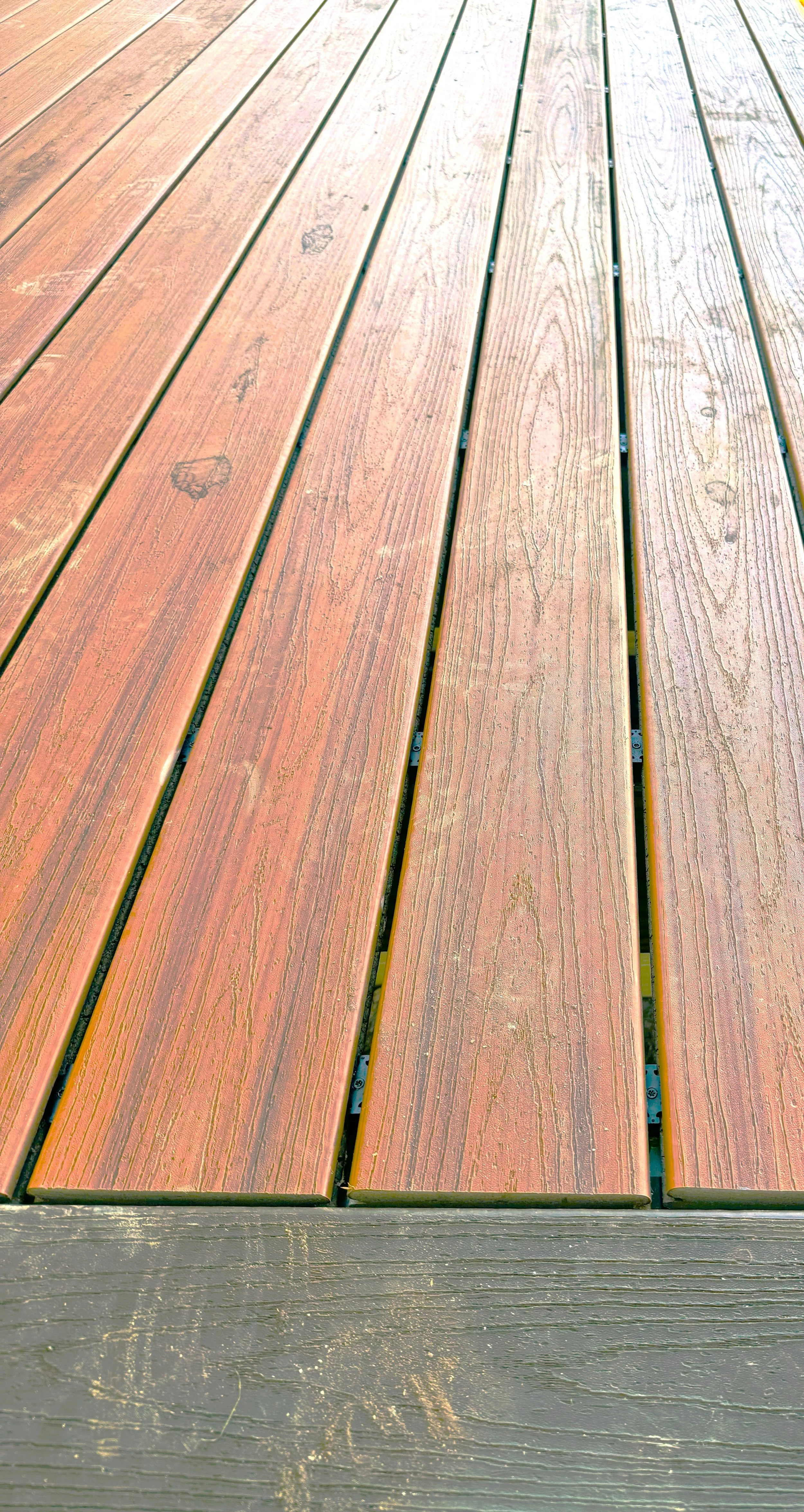The Pros and Cons of Composite Decking
Wood decking can be wonderful but hard to maintain. So why not explore composite decking with the Graber Custom Remodeling team? Check this blog out for the pros and cons of composite decking from our professionals!
The Pros and Cons of Composite Decking: What You Need to Know Before You Build
As professional deck builders, weI’ve spent years helping homeowners choose the perfect decking material for their outdoor spaces. One of the most popular options on the market today is composite decking, and for good reason. However, before you dive headfirst into a composite decking project, it’s essential to weigh both its advantages and disadvantages. In this comprehensive guide, you’ll get a breakdown of everything you need to know about composite decking, helping you make an informed decision that’s right for your home.
What is Composite Decking?
Composite decking is made from a blend of wood fibers and plastic, which creates a material that mimics the appearance of natural wood while offering enhanced durability. It’s available in various colors and textures, allowing homeowners to achieve the aesthetic they desire without the maintenance hassles associated with traditional wood.
Advantages of Composite Decking
1. Low Maintenance
One of the standout benefits of composite decking is its low maintenance requirements. Unlike traditional wood, which needs regular staining, sealing, and cleaning, composite decking is designed to withstand the elements with minimal effort. A simple soap and water wash is often all you need to keep your deck looking fresh.
2. Durability and Longevity
Composite decking is engineered to resist fading, scratching, and staining. This durability means it can withstand heavy foot traffic, harsh weather conditions, and even spills from food and drinks. Most composite decking brands offer warranties of 25 years or more, so you can enjoy your outdoor space for decades without worrying about wear and tear. The key here is to have it installed properly to ensure that the warranties remain intact and you get the most out of your new deck.
3. Environmentally Friendly
Many composite decking products are made from recycled materials, which can be a significant selling point for environmentally conscious homeowners. By choosing composite, you’re not only getting a great product but also contributing to a more sustainable future. Even though wood products that are cared for properly can last a long time, they do not really compete with the life of composite material. This means that over time fewer materials are needed to sustain composite decking and of course less lumber.
4. Aesthetic Appeal
Composite decking comes in a wide array of colors and textures, giving homeowners plenty of options to customize their outdoor spaces. Whether you prefer a classic wood look or a more modern aesthetic, there’s a composite option to match your vision. It seems like every year there are more and more choices added to the palette.
5. Safety Features
Composite decking often comes with built-in safety features, such as slip resistance and heat resistance. This makes it an excellent choice for families with children or pets, as it minimizes the risk of accidents on your deck. Also, there is quite a bit less of a risk of chemicals bleeding from composite materials compared to treated wood products.
6. Resistance to Pests
Unlike natural wood, which can attract termites and other pests, composite decking is pest-resistant. This can save you the headaches and costs associated with pest control and repairs in the long run.
Disadvantages of Composite Decking
While composite decking offers numerous advantages, it’s essential to consider its downsides as well. Here are some factors to keep in mind:
1. Initial Cost
One of the most significant drawbacks of composite decking is its upfront cost. Composite materials can be more expensive than traditional wood decking. However, it’s important to consider the long-term savings in maintenance and replacement costs. Over time, composite decking can be a more economical choice.
2. Heat Retention
Composite decking can absorb heat, making it uncomfortably hot to walk on during the summer months, especially in direct sunlight. If you live in a particularly warm climate, you might want to consider this factor when making your decision. Some brands offer cooler materials, but it’s worth doing your research.
3. Limited Repair Options
If your composite decking gets damaged, repairing it can be more challenging than with wood. Unlike wood, which can be sanded down or patched, composite materials may require complete board replacement, which can be a hassle.
4. Color Fading
While many composite decking brands claim their products are fade-resistant, some homeowners report that colors can fade over time, particularly in areas with intense sunlight. It’s essential to read reviews and choose high-quality products to minimize this risk.
5. Installation Complexity
Installing composite decking can be more complex than traditional wood, requiring specific tools and techniques. This is where hiring a professional deck builder can save you time and ensure a proper installation, but it may also add to the overall project cost.
Making the Right Choice for Your Home
When deciding whether composite decking is the right choice for your outdoor space, consider your lifestyle, budget, and aesthetic preferences. Here are a few questions to ask yourself:
What is your budget? While the initial cost of composite decking may be higher, think about the long-term savings in maintenance and repairs.
How much time do you want to spend on maintenance? If you’re looking for a hassle-free option, composite decking could be your best bet.
What’s your climate like? If you live in a hot area, research composite brands that offer heat-resistant options.
How long do you plan to stay in your home? If you’re looking for a long-term investment, composite decking’s durability might make it worth the upfront cost.
Conclusion
Composite decking is an excellent option for many homeowners, offering a combination of aesthetic appeal, durability, and low maintenance. However, it’s essential to consider both the advantages and disadvantages before making a decision. The Graber Custom Remodeling team recommends researching different brands, reading customer reviews, and consulting with a decking expert to find the best fit for your needs.
Ultimately, the right decking choice can enhance your outdoor living experience, providing a beautiful and functional space for years to come. If you have any questions or need further guidance, feel free to reach out. The team is here to help you make the best decision for your home!
Expert Tips for a Lavish Luxury Bathroom
A bathroom is just a room with a bath in it until you make it bespoke with the luxury amenities and upgrades. The team at Graber Custom Remodeling know a thing or two about transforming a bathroom into a haven of luxury.
Luxury bathroom remodeling is not just about enhancing aesthetics—it's about creating a sanctuary that combines opulence with functionality. True luxury is not about the latest fad, it is more about the quality of life around your aesthetic. As a seasoned contractor specializing in high-end renovations, I’m here to guide you through the essential steps for a stunning transformation. Let’s dive into the key elements that will turn your ordinary bathroom into a luxurious retreat.
1. Design with Elegance in Mind
The first step in any luxury bathroom remodel is choosing a design that reflects sophistication and style. Opt for timeless aesthetics like sleek marble countertops, elegant freestanding tubs, and custom cabinetry. Incorporate high-end finishes such as gold or chrome fixtures and stylish, large-format tiles. A well-thought-out design should seamlessly blend functionality with high-end appeal, ensuring that every detail contributes to a cohesive and luxurious look.
2. Invest in High-Quality Materials
The quality of materials makes a significant difference. Consider premium options like natural stone, high-grade porcelain, and exotic woods. These materials not only offer durability but also add a sense of opulence to the space. Remember, investing in quality materials now will pay off in the long run by reducing maintenance and enhancing your bathroom’s longevity.
3. Upgrade Your Fixtures and Fittings
To truly achieve a luxury feel, focus on upgrading fixtures and fittings. Install a state-of-the-art rain shower system, a high-efficiency toilet with modern features, and a sleek, vessel sink. Don’t forget about the little details—designer faucets, heated towel racks, and built-in lighting can significantly elevate the space. High-end fixtures not only enhance functionality but also add a touch of sophistication.
4. Incorporate Smart Technology
Embrace modern convenience with smart technology. Install programmable lighting, automated temperature controls, and a high-tech sound system to create a truly luxurious experience. Smart mirrors with built-in lighting and defogging features are also a fantastic addition. These upgrades not only offer comfort but also contribute to the bathroom’s futuristic and high-end appeal.
5. Focus on Customization
Luxury is all about personalization. Custom-built elements, such as bespoke cabinetry, tailor-made storage solutions, and unique vanities, ensure that your bathroom meets your specific needs and preferences. Working with a skilled contractor can help you design and execute these custom features with precision, turning your vision into reality.
6. Create a Relaxing Atmosphere
A high-end bathroom should be a haven for relaxation. Consider adding a spa-like touch with features such as a soaking tub, a steam shower, or a built-in bench. Integrate calming colors, plush towels, and soft, ambient lighting to create a serene atmosphere. The goal is to design a space where you can unwind and rejuvenate, turning your daily routine into a luxurious experience.
7. Plan for Lighting and Ventilation
Proper lighting and ventilation are crucial. Layer your lighting with a combination of ambient, task, and accent lights to highlight architectural features and enhance functionality. Good ventilation is equally important to prevent moisture build-up and maintain a fresh, inviting environment. High-quality exhaust fans and strategically placed windows can make a significant difference.
8. Don’t Overlook the Details
The details matter. Ensure that every element, from the grout lines to the cabinet handles, is meticulously crafted and perfectly installed. Pay attention to the finishing touches, such as coordinating color schemes and adding stylish decor elements, to tie the entire design together.
Conclusion
Luxury bathroom remodeling is an investment in both comfort and value. By focusing on elegant design, high-quality materials, advanced fixtures, and personalized touches, you can create a space that offers both functionality and indulgence. Any professional contractor, who knows their business, should make it their goal to help you bring your vision to life with precision and style. Always remember that luxury is not a fad.
Top of Form
Bottom of Form
Don't Rush, Plan!
There’s urgency and then there is emergency. A tree that goes through your garage is different than outgrowing your kitchen. We all feel the need to get things done and the sooner the better. Of course, the best way to ensure the fastest completion and the highest satisfaction is by putting a lot of effort into the plan. As the homeowner, your part of the plan started before you even knew you had a project. Those times where you said, “I wish I had” or you mentioned to someone “I could just”, these are the foundations of your plan. They are the musts, the reasons you are looking for something fresh. And they pay dividends when it comes to the plan. The fact is, they came to you when you were not in a hurry to get it done. Take your time write down the outcomes you want and really get into the planning part of the project. Then dig in with your designer and contractor on the front end of the project. Remember that the best ideas come to you at the pace of normal living. The most exciting ideas happened before the project started and will lead to the best experiences during the project. If you Bottom line, spend more time than you think in the planning phase. Cheers!


